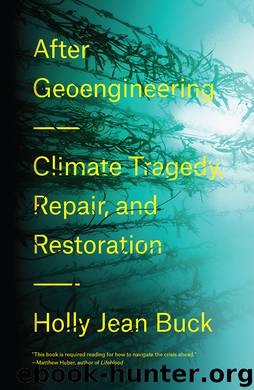After Geoengineering by Holly Jean Buck

Author:Holly Jean Buck
Language: eng
Format: epub
Publisher: Verso Books
Turning gas into stone
One way to speed up carbon mineralization is to inject concentrated CO2 with water into rock at high temperatures (in mineral weathering parlance, an “in situ” method, as it takes place within the rock, underground). This technique was used at Iceland’s geothermal Hellisheiði Power Station, at a project called CarbFix, where CO2 that bubbles up with the magma that fuels the geothermal plant was mixed with water and hydrogen sulfide—carbonating it, essentially into “seltzer.” Then, the mixture was injected into basalt rocks 400 to 800 meters below ground. Basalt is the most common volcanic rock—it underlies the oceans—and when filled with this soda water, its pores fill up with limestone. The results? Ninety-five percent of the injected CO2 had turned into mineral within two years.1
Turning carbon dioxide into rock underground seems much more attractive than storing it as a fluid, from an intuitive standpoint. It’s permanent, for one. West says, “I do think that there’s a sense of security in turning CO2 into a mineral form, one that isn’t gained by trying to put it somewhere where it’s still a fluid, ‘cause fluids move. Minerals move, but they’re solid.” The CarbFix project has even installed an air capture device, moving it toward being a true negative emissions technology.
Inevitably, there are questions about scalability, especially around the energy and financial costs. This particular project in Iceland is also very water intensive, requiring about twenty-five tons of water for every ton of CO2. This means it might not be a good option in semiarid regions. One option could be to do it offshore—where it would have a ready supply of water, and would not conflict with land uses. But working in offshore environments would also increase the expense. The most suitable areas are 200 to 400 kilometers from land, necessitating pipelines, and their depth is around 2,700 meters, meaning that even a demonstration-scale project would be quite costly.2 Nevertheless, this is an exciting new area of research.
Download
This site does not store any files on its server. We only index and link to content provided by other sites. Please contact the content providers to delete copyright contents if any and email us, we'll remove relevant links or contents immediately.
Man-made Catastrophes and Risk Information Concealment by Dmitry Chernov & Didier Sornette(5921)
The Revenge of Geography: What the Map Tells Us About Coming Conflicts and the Battle Against Fate by Kaplan Robert D(4034)
Zero Waste Home by Bea Johnson(3777)
COSMOS by Carl Sagan(3553)
Good by S. Walden(3485)
In a Sunburned Country by Bill Bryson(3481)
The Fate of Rome: Climate, Disease, and the End of an Empire (The Princeton History of the Ancient World) by Kyle Harper(3003)
A Wilder Time by William E. Glassley(2818)
Camino Island by John Grisham(2762)
The Ogre by Doug Scott(2631)
Organic Mushroom Farming and Mycoremediation by Tradd Cotter(2626)
Human Dynamics Research in Smart and Connected Communities by Shih-Lung Shaw & Daniel Sui(2465)
Energy Myths and Realities by Vaclav Smil(2437)
The Traveler's Gift by Andy Andrews(2409)
9781803241661-PYTHON FOR ARCGIS PRO by Unknown(2321)
Inside the Middle East by Avi Melamed(2305)
Birds of New Guinea by Pratt Thane K.; Beehler Bruce M.; Anderton John C(2223)
A History of Warfare by John Keegan(2184)
Ultimate Navigation Manual by Lyle Brotherton(2129)
